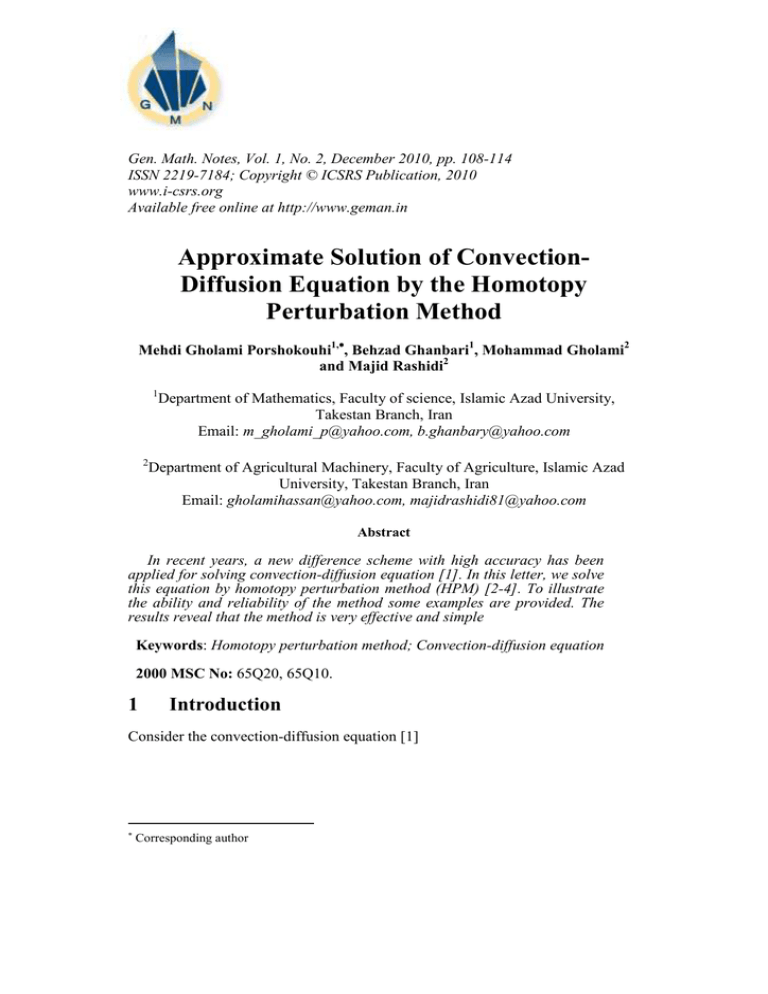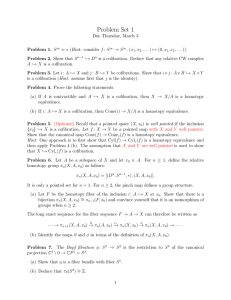Gen. Math. Notes, Vol. 1, No. 2, December 2010, pp.... ISSN 2219-7184; Copyright © ICSRS Publication, 2010
advertisement

Gen. Math. Notes, Vol. 1, No. 2, December 2010, pp. 108-114 ISSN 2219-7184; Copyright © ICSRS Publication, 2010 www.i-csrs.org Available free online at http://www.geman.in Approximate Solution of ConvectionDiffusion Equation by the Homotopy Perturbation Method Mehdi Gholami Porshokouhi1,∗∗, Behzad Ghanbari1, Mohammad Gholami2 and Majid Rashidi2 1 2 Department of Mathematics, Faculty of science, Islamic Azad University, Takestan Branch, Iran Email: m_gholami_p@yahoo.com, b.ghanbary@yahoo.com Department of Agricultural Machinery, Faculty of Agriculture, Islamic Azad University, Takestan Branch, Iran Email: gholamihassan@yahoo.com, majidrashidi81@yahoo.com Abstract In recent years, a new difference scheme with high accuracy has been applied for solving convection-diffusion equation [1]. In this letter, we solve this equation by homotopy perturbation method (HPM) [2-4]. To illustrate the ability and reliability of the method some examples are provided. The results reveal that the method is very effective and simple Keywords: Homotopy perturbation method; Convection-diffusion equation 2000 MSC No: 65Q20, 65Q10. 1 Introduction Consider the convection-diffusion equation [1] ∗ Corresponding author 109 (1) Approximate solution of convection-diffusion equation by the HPM ∂u ∂u ∂ 2u +ε =γ 2 ∂t ∂x ∂x 0 ≤ x ≤ 1, t ≥ 0. Subject to the initial condition, u ( x, 0 ) = g ( x ) , conditions u ( 0, t ) = 0, 0 ≤ x ≤ 1 and boundary t ≥ 0. u (1, t ) = 0, t ≥ 0. where the parameter γ is the viscosity coefficient and ε is the phase speed and both are assumed to be positive. g is a given function of sufficient smoothness. To illustrate the basic concepts of homotopy perturbation method, consider the following non-linear functional equation: A ( u ) = f ( r ) , r ∈Ω, ( 2) With the following boundary conditions: ( B u, ∂u ) = 0, r ∈ Γ. ∂n Where A is a functional operator, B is a boundary operator, f ( r ) is a known analytic function, and Γ is the boundary of the domain Ω . Generally speaking, the operator A can be decomposed into two parts L and N , where L is a linear and N is a non-linear operator. Therefore Eq. ( 2 ) can be rewritten as the following: ( 3) L ( u ) + N ( u ) − f ( r ) = 0. We construct a homotopy v(r , p) : Ω × [ 0,1] → R, which satisfies: H ( v, p ) = (1 − p ) L ( v ) − L ( u0 ) + p A ( v ) − f ( r ) = 0, p ∈ [ 0,1] , r ∈ Ω. Or H ( v, p ) = L ( v ) − L ( u0 ) + pL ( u0 ) + p N ( v ) − f ( r ) = 0, p ∈ [ 0,1] , r ∈ Ω. , Where u0 is an initial approximation to the solution of Eq. ( 2 ) . In this method, homotopy perturbation parameter p is used to expand the solution, as a power series, say; v = v0 + pv1 + p 2 v2 +⋯ , Mehdi Gholami Porshokouhi et al. 110 Usually an approximation to the solution, will be obtained by taking the limit, as p tends to 1, u = lim v = v0 + v1 + v2 ⋯ , p →1 For solving Eq. (1) , by homotopy perturbation method, we construct the following homotopy: ∂v ∂u 0 − ∂t ∂t (1 − p ) + ∂v ∂v ∂ 2v p +ε − γ 2 = 0, ∂x ∂x ∂t Or ∂v ∂v ∂u0 ∂ 2 v ∂u − + p ε − γ 2 + 0 = 0, ∂t ∂t ∂x ∂t ∂x Suppose that the solution of Eq. ( 4 ) to be in the following form ( 4) ( 5) v = v0 + pv1 + p 2v2 +… Substituting Eq. ( 5 ) into Eq. ( 4 ) , and equating the coefficients of the terms with the identical powers of p , ∂v0 ∂u0 − = 0, ∂t ∂t ∂v ∂u ∂v ∂ 2v0 p1 : 1 + 0 + ε 0 − γ = 0, ∂t ∂t ∂x ∂x 2 ∂v ∂v ∂ 2v p 2 : 2 + ε 1 − γ 21 = 0, ∂t ∂x ∂x ∂v ∂v ∂ 2 v2 p3 : 3 + ε 2 − γ = 0, ∂t ∂x ∂x 2 ⋮ p0 : j p : ∂v j ∂t +ε ∂v j −1 ∂x −γ ∂ 2v j −1 ∂x 2 = 0, v1 ( x, 0 ) = 0 v2 ( x, 0 ) = 0 v3 ( x, 0 ) = 0 v j ( x, 0 ) = 0 ⋮ For simplicity we take v0 ( x, t ) = u0 ( x, t ) = u ( x, 0 ) Having this assumption we get the following iterative equation ∂ 2v j −1 ∂v j −1 vj = ∫ γ −ε dt , 2 0 ∂x ∂x t j = 1, 2,3,... 111 Approximate solution of convection-diffusion equation by the HPM Therefore, the approximated solutions of Eq. (1) can be obtained, by setting p = 1 u = lim v = v0 + v1 + v2 + v3 + ... p →1 2 numerical examples In this section, we present examples of convection-diffusion equation and results will be compared with the exact solutions. Example1. Let us consider the convection-diffusion equation ∂u ∂u ∂ 2u + 0.1 = 0.01 2 ∂t ∂x ∂x 0 ≤ x ≤ 1, t ≥ 0. With the following initial condition u ( x, 0 ) = e5 x sin π x . 5 x − 0.25− 0.01π ) t The exact solution is u x, t = e ( sin π x . ( ) 2 Approximation to the solution of example 1 can be readily obtained by 20 u20 = ∑ vi i =0 The results corresponding absolute errors are presented in Fig.1. Fig.1. The absolute error between exact and numerical solutions in Example 1. Mehdi Gholami Porshokouhi et al. 112 Example 2. Consider the following the convection-diffusion equation with boundary conditions u ( x, 0 ) = e0.22 x sin π x . The exact solution is u ( x, t ) = e ( ) 0.22 x − 0.0242 + 0.5π 2 t ∂u ∂u ∂ 2u + 0.22 = 0.5 2 ∂t ∂x ∂x sin π x . 0 ≤ x ≤ 1, t ≥ 0. Approximation to the solution of example 2 can be readily obtained by 20 u20 = ∑ vi i =0 The results corresponding absolute errors are presented in Fig.2. Fig.2. The absolute error between exact and numerical solutions in Example 2. Example3. We consider the convection-diffusion equation with boundary conditions u ( x, 0 ) = e0.25 x sin π x . The exact solution is u ( x, t ) = e ∂u ∂u ∂ 2u + 0.1 = 0.2 2 ∂t ∂x ∂x ( ) 0.25 x − 0.0125 + 0.2π 2 t sin π x . 0 ≤ x ≤ 1, t ≥ 0. 113 Approximate solution of convection-diffusion equation by the HPM Approximation to the solution of example 3 can be readily obtained by 20 u20 = ∑ vi i =0 The results corresponding absolute errors are presented in Fig.3. Fig.3. The absolute error between exact and numerical solutions in Example 3. 4 Conclusion In this paper, we proposed the homotopy perturbation method for solving the convection-diffusion equations. The obtained solutions, in comparison with exact solutions admit a remarkable accuracy. The computations associated with the examples in this paper were performed using maple 10. References [1] H.Ding and Y.Zhang, A new difference scheme with high accuracy and absolute stability solving convection-diffusion equations, J. Comput. Appl. Math. 230(2009), 600–606. [2] J-H. He, Homotopy perturbation technique. Comput Methods Appl Mech Eng 1999;178(3/4), 257–62. Mehdi Gholami Porshokouhi et al. [3] J-H. He, Homotopy perturbation method: a new nonlinear analytical technique, Appl Math Comput, 135( 2003), 73–9. [4] J-H. He, A coupling method of homotopy technique and perturbation technique for nonlinear problems, Int J Nonlinear Mech, 35(1) (2000), 37–43. 114






